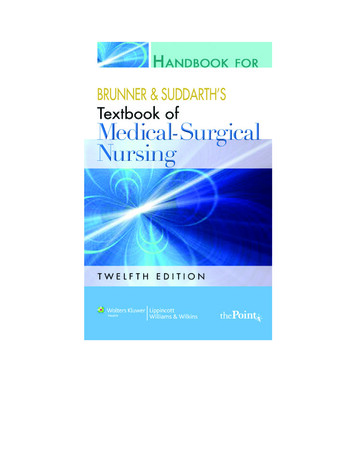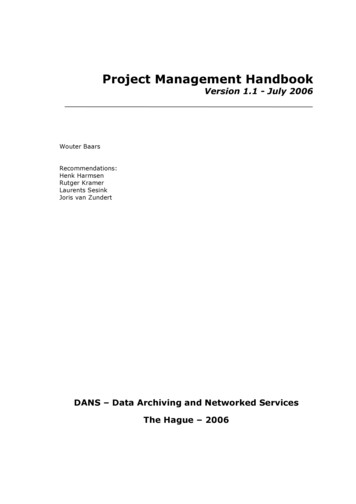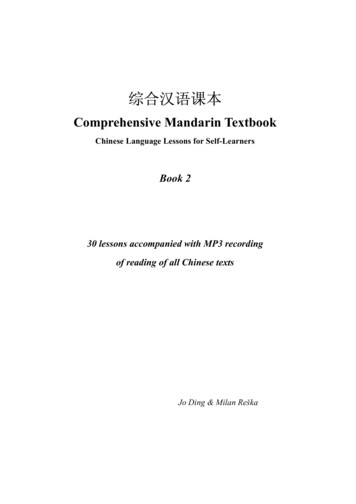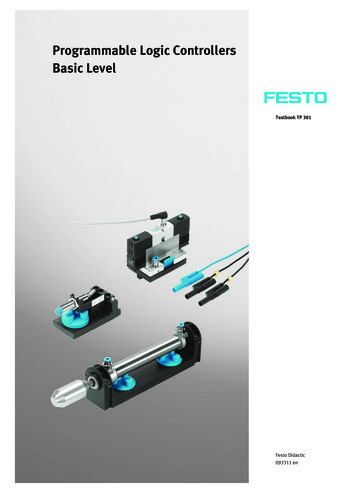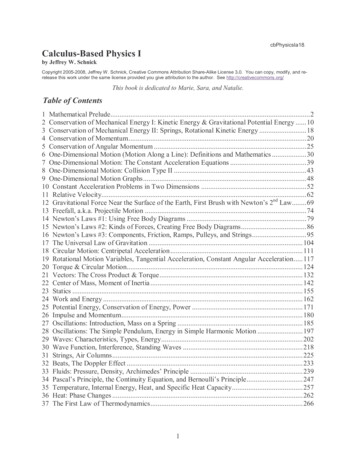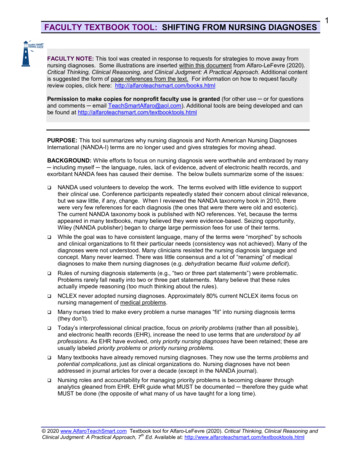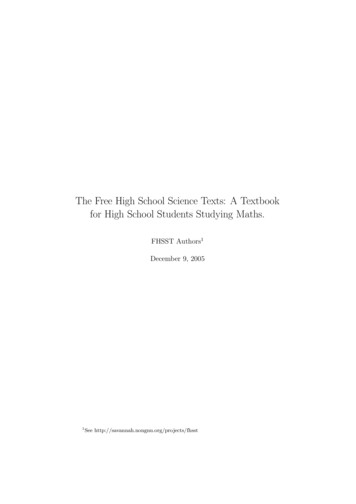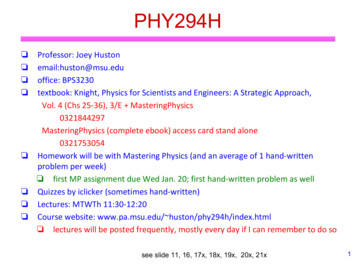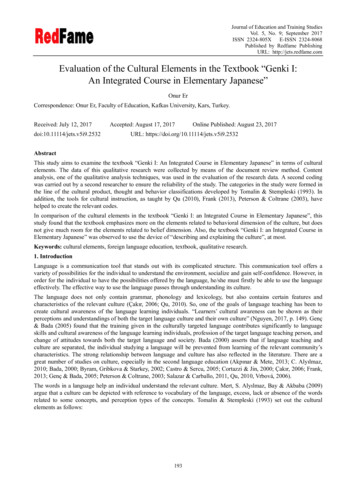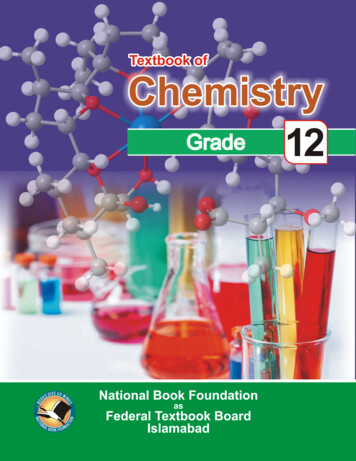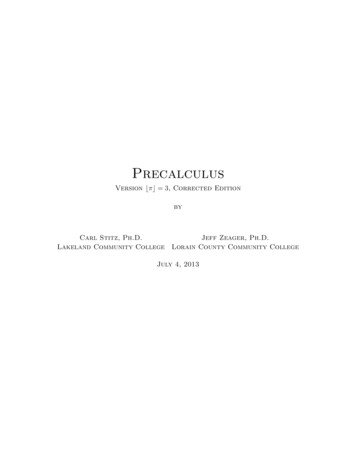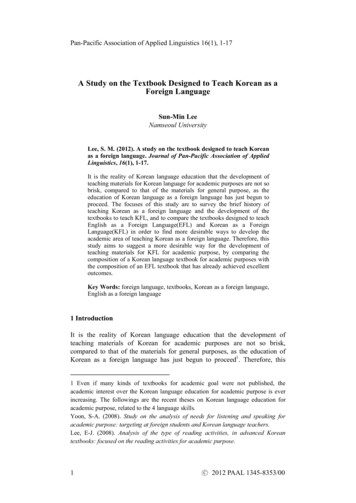
Transcription
Pan-Pacific Association of Applied Linguistics 16(1), 1-17A Study on the Textbook Designed to Teach Korean as aForeign LanguageSun-Min LeeNamseoul UniversityLee, S. M. (2012). A study on the textbook designed to teach Koreanas a foreign language. Journal of Pan-Pacific Association of AppliedLinguistics, 16(1), 1-17.It is the reality of Korean language education that the development ofteaching materials for Korean language for academic purposes are not sobrisk, compared to that of the materials for general purpose, as theeducation of Korean language as a foreign language has just begun toproceed. The focuses of this study are to survey the brief history ofteaching Korean as a foreign language and the development of thetextbooks to teach KFL, and to compare the textbooks designed to teachEnglish as a Foreign Language(EFL) and Korean as a ForeignLanguage(KFL) in order to find more desirable ways to develop theacademic area of teaching Korean as a foreign language. Therefore, thisstudy aims to suggest a more desirable way for the development ofteaching materials for KFL for academic purpose, by comparing thecomposition of a Korean language textbook for academic purposes withthe composition of an EFL textbook that has already achieved excellentoutcomes.Key Words: foreign language, textbooks, Korean as a foreign language,English as a foreign language ͑1 IntroductionIt is the reality of Korean language education that the development ofteaching materials of Korean for academic purposes are not so brisk,compared to that of the materials for general purposes, as the education ofKorean as a foreign language has just begun to proceed1. Therefore, this1 Even if many kinds of textbooks for academic goal were not published, theacademic interest over the Korean language education for academic purpose is everincreasing. The followings are the recent theses on Korean language education foracademic purpose, related to the 4 language skills.Yoon, S-A. (2008). Study on the analysis of needs for listening and speaking foracademic purpose: targeting at foreign students and Korean language teachers.Lee, E-J. (2008). Analysis of the type of reading activities, in advanced Koreantextbooks: focused on the reading activities for academic purpose.1C 2012 PAAL 1345-8353/00Ϥ
Sun-Min Leestudy aims to suggest a more desirable way for development of teachingmaterials for KFL(Korean as a Foreign Language) for academic purposes, bycomparing the composition of Korean textbook for academic purpose withthe composition of an EFL(English as a Foreign Language) textbook foracademic purpose that has already achieved excellent outcomes.The textbook series of College Korean for foreign studentsૹ byEwha Womans University Language Center, is distinguished as they havedrawn a line between the colloquial language literacy and written languageliteracy, classifying language skills only into the two section namely'Speaking and Listening' and 'Reading and Writing'. This series of books isconsidered to be more efficient and effective than other textbooks where thefour language skills are divided individually or combined together becausethe learners who are weak in colloquial language literacy can select one of thetextbook for 'Speaking and Listening' and the learners who are weak in writtenlanguage literacy can select one of the textbook for 'Reading and Writing'.Regarding English textbooks, the series of Northstarૹ, ESLtextbooks for academic goal(divided by ‘Listening and Speaking’ and‘Reading and Writing’), was noticed to have the same way of classification.Thus, the researcher intends to analyze the strong points and weak points ofthe textbook series of College Korean for foreign studentsૹ by EwhaWomans University, comparing its composition with that of Northstarૹtextbook series. The Northstarૹ series offers book 1 to book 5 and theseries of College Korean for foreign studentsૹ offers book 1 to book 2.So the book 3 of Northstarૹ and book 2 of College Korean forforeign studentsૹ which both fall under the category of intermediate level,were selected to be compared. The reason why book 2 of College Koreanfor foreign studentsૹ was selected out of book 1 and book 2, is that theresearcher considered the first book of series is normally less definite interms of systematic regularity and unity. Consequently, 4 books, Northstar:Listening and Speaking 3ૹ, Northstar: Reading and Writing 3ૹ,Park, S-A. (2009). Research on the training of Korean writing for academic purpose.Sohn, J-R. (2009). The Effect of Training Note-taking Strategies on LectureComprehension for Learners of Korean for Academic Purposes.Oh, Y-J. (2009). Effects of a Genre-based Instruction on Chinese KAP Learners'Writing in Korean.Chung, H-Y. (2009). A Study on the development of listening textbook for academicpurpose learners: focusing on the strategy of writing down the lectures.Park, G-J. (2010). A Study on Class Speaking Assessment Method for KoreanLearners for Academic purpose.Lee, B. (2011). A study on korean language of listening textbook content selection forthe Chinese academic purposes learners.Chun, B-O. (2011). A Study on Improvement of Extensive Reading Skills of KoreanLanguage Learners for Academic Purpose.2
A Study on the Textbook Designed to Teach Korean College Korean for foreign students 2-Speaking and Listening-ૹand College Korean for foreign students 2-Reading and Writing-ૹarecompared in this article.2 Theoretical Background2.1 The role of textbook in the foreign language educationThe role of the textbook is considered to be really important in an educationalsituation. In order to make a textbook be in line with the learner's quality andobjective, it is necessary to accurately define the role of a textbook also in thesituation of foreign language education. To compare and analyze thetextbook of KFL and EFL, the researcher decided to adopt the textbooktheory in the English education field as a theoretical basis, because theresearch history of English as a foreign language is comparatively longerthan others.According to the theory of Tom Hutchinson & Eunice Torres (1994)regarding the role of ESL(English as a foreign language) textbook, the role ofthe textbook comes as follows.First, a textbook provides the basis of a dialogue. The most salienttendency, developed recently in the situation of English education, is thatlearner-centric education through dialogue is being supported. Under thiscircumstance of new trend, peoples tend to perceive that the textbook disruptsdialogues. But not only does the textbook provide the most concrete subjectof debate in an educational situation, it also provides a structure to control theclassroom instruction, a social interaction and it arranges the basis of adialogue among participants.Second, a textbook provides a flexible outline of learning process.English education pursues to develop the creativity of the teacher andlearners as much as possible and the creativity can be most effectivelydeveloped through a structural outline. In this respect, a textbook is regardedto be a flexible outline which develops the creativity of all the learners,participating in the learning process.Third, a textbook is an object that can be debated clearly and freely.As a textbook provides a clear object to study in a learning process, it canexpedite a dialogue process that is free and definite.Fourth, a textbook is encouraging the teachers' advance. Highlystructuralized textbook are easily considered to deprive teachers of theopportunity to develop teaching skill but a textbook of good quality can helpthe teachers in saving their time and ardor to develop their own textbooks andas a result, make teachers be able to cope with new trends in Englisheducation or to invest more time in developing themselves.Fifth, realistic negotiation becomes possible through the textbook. Theimportance of a textbook is apt to be downgraded in that a textbook cannot3
Sun-Min Leeaccommodate all the learners' needs but, if the learners' preference, interestand requirement are reflected, to maximum extent, in the selection oftextbook's contents, a textbook can play the definite and real role, satisfyingthe learners' demand. According to Chang(1995), the role of English textbookis defined to be the implementation of an educational course, the promoter ofinteractive class and a medium of change. Above all, the textbook of Englishis a physical object that presents the true nature of educational course. Wecan say the textbook of English is an entity that implements the ideals of theeducational course, for the textbook is influencing the real educational coursein a classroom and it can analyze, assess and amend the real educationalcourse. Also in a model of the interactive classroom, teachers assess thetextbook as something that assists teachers in leading their classes, makingteaching course easier, better organized and more convenient. The textbookplays the role of energizer for dynamic class development, instillingconfidence and stability into all the class participants. In the last place, theEnglish textbook can be defined as a medium which conveys the impact ofchanges most concretely and clearly in the overall context of education. Ifany educational change marches with no textbook, all the persons, relevant toan educational course, might feel an air of anxiety, for they cannot see theprocess of change and imagine the future paradigm. Only the textbook is tomake all the participants understand the change and to provide anorganizational level and the confidence which are necessary to cope with thechanges. The role of the textbook that is defined as the implementation of aneducational course, the promoter of interactive class and a medium of change.is so important that no other educational element can be substituted for it.Hence, the textbook research occupies an essential position in the educationfield, especially in the field of English education.2.2 The development of textbook analysis theoriesIn this section, the brief historical survey of the development of textbookanalysis theories will be discussed in order to establish the theoreticalfoundation for analyzing the textbooks designed to teach EFL and KFL. In1970s the scholars such as A. Daoud & M. Murcia(1979), C.A. Tucker(1978),M.N. Bruder(1978), H.H. Cowles(1976) and E.W. Stevick(1972), introducedthe theory of English textbook analysis for the first time, and analysisstandards were established in detail and the results of analysis were shown inobjective form of numeric or rating. We notice that the subjective evaluationby the evaluator was requested in 1980s, by the scholars like L.E.Sheldon(1988), J. Dougill, A. Cuunningsworth(1984) and W. Rivers(1981),the upper categories of analysis standards were established to organizecomprehensively the detailed items of analysis standards in 1980s. Besidesmore comprehensive parent category like Macro-evaluation/Microevaluation of J. MacDough & C. Shaw(1993) was emphasized in 1990s. We4
A Study on the Textbook Designed to Teach Koreanneed to analyze the existing English textbook in order to develop an Englishtextbook which fits for Korean circumstances of English education. And, asregards the establishment of analysis standards, the changing phase ofanalysis theory by the times implies that we should not turn to simpleexperience or vague intuition with no theoretical basis but establish theanalysis standards upon carrying out a thorough theoretical analysis andstudy. Also it is essential prerequisite of the construction of theoretical basisto understand exhaustively the detailed features of each analysis theory inforeign countries and the overall transition process to date. It was madepublic that the setting and scope of English textbook analysis standards are tobe decided depending on the subjective views of the related scholar, uponstudying the theory of English textbook analysis that began to develop from1970s. When we consider the issue of textbook development for KFL(Koreanas a foreign language) and English, based on such facts, mentioned above, wecome to recognize that we should not introduce a foreign theory without anymodification, but arrange our own standards for the current textbooks, uponconsider a foreign theory's connectivity with our curriculum, therequirements of learners and our unique cultural background all together.Hence, the researcher views that the urgent problem with our foreignlanguage education is to set the direction for which our production of aforeign language textbook moves forward, based on such a recognition asseen in the preceding paragraph.3 Research MethodologyFor the research purposes, the researcher adopted the textbook Northstarૹ for EFL and College Korean for foreign studentsૹ forKFL. The textbook series of Northstarૹ, ESL textbooks for academicgoal(divided by ‘Listening and Speaking’ and ‘Reading and Writing’), wasnoticed to have the same way of classification. Thus, the researcher intends toanalyze the strong points and weak points of the textbook series of College Korean for foreign studentsૹ by Ewha Womans University,comparing its composition with that of Northstarૹ series. The Northstarૹ series was published from book 1 to book 5 and the series of College Korean for foreign studentsૹ was published from book 1 to book2. So the book 3 of Northstarૹ and book 2 of College Korean forforeign studentsૹ that fall under the category of intermediate level, wereselected to be compared. The reason why the book 2 of College Koreanfor foreign studentsૹ was selected instead of book 1 is that the researcherconsidered the first book of a series is normally less definite in terms of thesystematic regularity and unity. Consequently, the 4 books of Northstar:Listening and Speaking 3ૹ, Northstar: Reading and Writing 3ૹ, College Korean for foreign students 2-Speaking and Listening-ૹ and College Korean for foreign students 2-Reading and Writing-ૹ are this5
Sun-M
textbook which fits for Korean circumstances of English education. And, as regards the establishment of analysis standards, the changing phase of analysis theory by the times implies that we should not turn to simple experience or vague intuition with no theoretical basis but establish the analysis standards upon carrying out a thorough theoretical analysis and study. Also it is essential .
